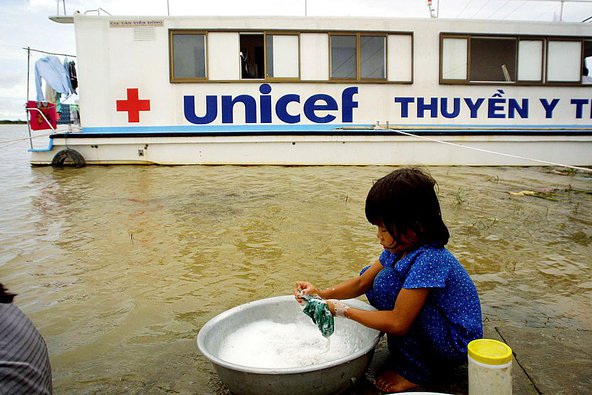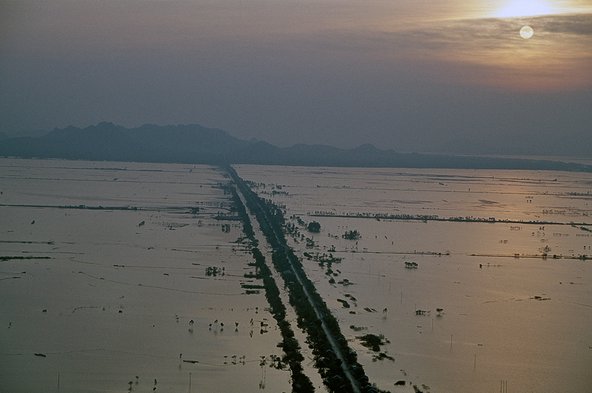Working with communities to manage Mekong Delta floods
by Dr Oliver Hensengerth
21 Jun 2018
This blog is part of our Summer Showcase series, celebrating our free festival of ideas for curious minds.
For people living in the Mekong Delta in south Vietnam, flooding is a regular part of life. Each year the Mekong River receives around 475 km³ of rain upstream, with around 70-80% of that volume falling during the wet season between July and December. Like floods everywhere, the floods in the Mekong Delta pose serious risks to the region and its inhabitants. As well as damaging property, agriculture and infrastructure, the floods are often deadly, with children and the elderly particularly at risk of drowning. In October 2001, 222 people – 182 of whom were children – died as waters in the Mekong Delta rose to dangerously high levels, while tens of thousands of houses, belonging to over one million people, were damaged, resulting in the evacuation of 105,000 people.

The floods destroy but are essential for the region
However, as dangerous as they are, the Mekong Delta floods are also essential to life in the region. They bring nutrient-rich sediments that are key to agriculture and, as the delta produces more than half of Vietnam’s rice and 90% of its exportable grain, the importance of the arrival of these nutrients each year cannot be overstated. Put simply, floods in the Mekong Delta form an integral part of the local eco-system, and the health and prosperity of the people who live there.
So, the question facing the governments in charge of managing the Mekong Delta floods is: how do you balance the need to protect people and property with the need to ensure the region receives the sustenance it needs to produce its crops and survive economically?
It is a difficult ask and one that is getting even harder as the twin forces of global climate change and infrastructure development (the need to build homes, roads, bridges, etc.) change the environment unalterably. Flood cycles are becoming more unpredictable and, by extension, more dangerous, while droughts are posing an increasingly severe threat to livelihoods. At the same time, human interference in the hydrological cycle is creating ever more artificial landscapes – the natural flood pulse is vanishing, and water flows are increasingly determined by dam reservoir release schedules and large-scale irrigation projects, creating artificial river flow. Responding to the challenges posed by floods is now more complex than ever.

Tensions between governments and locals
One of the main problems associated with managing the floods is the tension that arises between the governments and the inhabitants of the regions they oversee. In providing solutions to the Mekong Delta floods, Vietnam’s central government tends to impose flood policies that do not always reflect the wishes of the communities. For example, the government may wish to build a high dyke to keep flood water at bay while the local community may only want a medium dyke, resulting in protracted negotiations and stalled action.
Such policies are usually rooted in science but are rarely developed in consultation with the communities in question, the constituents of whom have decades of first-hand experience and knowledge to impart. For example, locals can often predict weather patterns by looking at cloud formations, water colour and even by tracking dragonfly paths. As a result, the inhabitants of the Mekong Delta are frequently resisting the imposition of ‘top-down’ government policies, claiming that they are incompatible with their needs.
Helping communities participate in research on flooding
To produce effective flood management policies, policy makers need to draw on the work of a diverse range of stakeholders with different livelihoods and combine local knowledge with professional and scientific expertise. The solutions need to consider not only farmers, urban populations, and local and national development objectives; they also need to draw on a range of disciplines to address the interaction between natural systems and humans. The ultimate objective should be to understand interactions between systemic change, complex governance problems, and local livelihood strategies.
To this end, my British Academy Newton Fund project brought together anthropologists, social scientists, engineers, policy makers, academics, students, think tank and government personnel, communities, and development practitioners to initiate the process of developing better flood management policies. Among a range of activities, together we organised interdisciplinary methods workshops; visited the Lake District in the UK, where we met with the local flood action committee; went on field trips to Vietnam, where we spoke with irrigation project managers and farmers; conducted teaching sessions with Vietnamese project partners on the MSc International Development at Northumbria University; and put on writing workshops at Vietnamese partner institutions.
My British Academy Summer Showcase exhibition, in collaboration with Maggie Roe at Newcastle University, shows how different stakeholder groups – including local communities and even children – can be involved in research in order to bring out their voices and challenge social and political norms for inclusive decision-making. For the Mekong Delta, important solutions include Delta-wide cooperation instead of planning by individual provinces; more emphasis on the local knowledge of farmers (including developing strategies on how to update this local knowledge as the climate system changes and infrastructure development makes reliance on the natural flood cycle problematic); and the diversification of livelihoods instead of sole reliance on intensive agriculture, which means farmers have more capacity to react flexibly to changes in floods and droughts.
Ultimately, we hope to work with people living in the Mekong Delta – and their governments – to learn from each other for the joint development of effective, safe and efficient flood policies, and to demonstrate that for flood policies to be truly successful, more consultation with local communities is required.
The projects were co-led by Dr Oliver Hensengerth (Northumbria University), Prof Dao Xuan Hoc (former rector of Thuyloi University and Deputy Minister of Agriculture and Rural Development) and Dr Nguyen Thi Lan Huong (Tuyloi University). Key partners included Jenty Kirsch-Wood (UNDP Vietnam); Dr Dang Tung Hoa (Institute for the Management of Agriculture and Rural Development IMARD); Dr Le Anh Tuan (Can Tho University); Dr Do Anh Tuan (IMARD); Dr Tran Thanh Tung (Thuy Loi University). Special thanks to Lynne Jones (Chair of the Keswick Flood Action Group), Maureen Fordham (Northumbria University), Paul Selman (formerly Sheffield University), Jacqui Cotton (Environment Agency), Heather Shepherd (National Flood Forum), Charles Howie (Royal Agricultural University), and Franz Krause (Cologne University).



